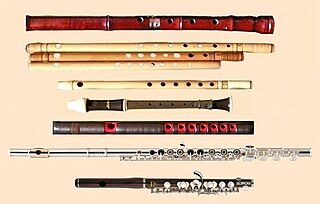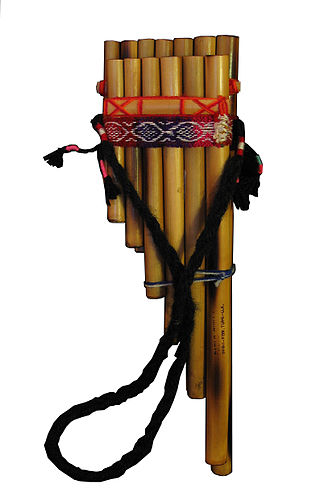
The flute is a member of a family of musical instruments in the woodwind group. Like all woodwinds, flutes are aerophones, producing sound with a vibrating column of air. Unlike woodwind instruments with reeds, a flute produces sound when the player's air flows across an opening. In the Hornbostel–Sachs classification system, flutes are edge-blown aerophones. A musician who plays the flute is called a flautist or flutist.

A pan flute is a musical instrument based on the principle of the closed tube, consisting of multiple pipes of gradually increasing length. Multiple varieties of pan flutes have been popular as folk instruments. The pipes are typically made from bamboo, giant cane, or local reeds. Other materials include wood, plastic, metal and ivory.

Woodwind instruments are a family of musical instruments within the greater category of wind instruments. Common examples include flute, clarinet, oboe, bassoon, and saxophone. There are two main types of woodwind instruments: flutes and reed instruments. The main distinction between these instruments and other wind instruments is the way in which they produce sound. All woodwinds produce sound by splitting the air blown into them on a sharp edge, such as a reed or a fipple. Despite the name, a woodwind may be made of any material, not just wood. Common examples include brass, silver, cane, as well as other metals such as gold and platinum. The saxophone, for example, though made of brass, is considered a woodwind because it requires a reed to produce sound. Occasionally, woodwinds are made of earthen materials, especially ocarinas.

A reed is a thin strip of material that vibrates to produce a sound on a musical instrument. Most woodwind instrument reeds are made from Arundo donax or synthetic material. Tuned reeds are made of metal or synthetics. Musical instruments are classified according to the type and number of reeds.
Hornbostel–Sachs or Sachs–Hornbostel is a system of musical instrument classification devised by Erich Moritz von Hornbostel and Curt Sachs, and first published in the Zeitschrift für Ethnologie in 1914. An English translation was published in the Galpin Society Journal in 1961. It is the most widely used system for classifying musical instruments by ethnomusicologists and organologists. The system was updated in 2011 as part of the work of the Musical Instrument Museums Online (MIMO) Project.

An aerophone is a musical instrument that produces sound primarily by causing a body of air to vibrate, without the use of strings or membranes, and without the vibration of the instrument itself adding considerably to the sound.
Overblowing is the manipulation of supplied air through a wind instrument that causes the sounded pitch to jump to a higher one without a fingering change or the operation of a slide. Overblowing may involve a change in the air pressure, in the point at which the air is directed, or in the resonance characteristics of the chamber formed by the mouth and throat of the player.

An organ stop is a component of a pipe organ that admits pressurized air to a set of organ pipes. Its name comes from the fact that stops can be used selectively by the organist; each can be "on", or "off".
The venu is one of the ancient transverse flutes of Indian classical music. It is an aerophone typically made from bamboo, that is a side blown wind instrument. It continues to be in use in the South Indian Carnatic music tradition. It is referred to as nadi and tunava in the Rigveda and other Vedic texts of Hinduism. In northern Indian music, a similar flute is called bansuri. In the south, it is also called by various other names such as pullanguḻal (புல்லாங்குழல்) in Tamil, oodakuḻal (ഓടകുഴൽ) or kurungu kuḻal in Malayalam (Kerala) and ಕೊಳಲು (koḷalu) or ಮುರಳಿ (muraļi) in Kannada (Karnataka). It is known as pillana grōvi or vēṇuvu (వేణువు) in Telugu. It is also called as Carnatic Flute.

A flue pipe is an organ pipe that produces sound through the vibration of air molecules, in the same manner as a recorder or a whistle. Air under pressure is driven through a flue and against a sharp lip called a labium, causing the column of air in the pipe to resonate at a frequency determined by the pipe length. Thus, there are no moving parts in a flue pipe. This is in contrast to reed pipes, whose sound is driven by beating reeds, as in a clarinet. Flue pipes are common components of pipe organs.

An organ pipe is a sound-producing element of the pipe organ that resonates at a specific pitch when pressurized air is driven through it. Each pipe is tuned to a note of the musical scale. A set of organ pipes of similar timbre comprising the complete scale is known as a rank; one or more ranks constitutes a stop.
The paixiao is a Chinese wind instrument, a form of pan flute. A major difference between the Chinese Paixiao and the panpipes used in European and South American traditions, is that at the top of the Chinese instrument the pipe holes are each cut angled or with notches. This allows for bending the pitch in similar capacity to the dongxiao down a minor second. This allows Chinese paixiao to be fully chromatic without loss in timbre, even though the included pipes are tuned diatonically. The method of blowing so is to hold the head of the frame with both hands, with the mouthpiece facing the front, place the lower lip on the mouthpiece, and find and blow each tube according to the pitch.

Philippine traditional musical instruments are commonly grouped into four categories: aerophones, chordophones, membranophones, and idiophones.

A wind instrument is a musical instrument that contains some type of resonator in which a column of air is set into vibration by the player blowing into a mouthpiece set at or near the end of the resonator. The pitch of the vibration is determined by the length of the tube and by manual modifications of the effective length of the vibrating column of air. In the case of some wind instruments, sound is produced by blowing through a reed; others require buzzing into a metal mouthpiece, while yet others require the player to blow into a hole at an edge, which splits the air column and creates the sound.
The whirly tube, corrugaphone, or bloogle resonator, also sold as Free-Ka in the 1960s-1970s, is an experimental musical instrument which consists of a corrugated (ribbed) plastic tube or hose, open at both ends and possibly wider at one end (bell), the thinner of which is rotated in a circle to play. It may be a few feet long and about a few inches wide. The faster the toy is swung, the higher the pitch of the note it produces, and it produces discrete notes roughly belonging to the harmonic series, like a valveless brass instrument generates different modes of vibration. However, the first and the second modes, corresponding to the fundamental and the second harmonics, are reported as being difficult to excite. To be played in concert the length of the tube must be trimmed to tune it.

Bamboo's natural hollow form makes it an obvious choice for many musical instruments. In South and South East Asia, traditional uses of bamboo the instrument include various types of woodwind instruments, such as flutes, and devices like xylophones and organs, which require resonating sections. In some traditional instruments bamboo is the primary material, while others combine bamboo with other materials such as wood and leather.
The kolitong is a bamboo polychordal tube zither from Bontok, Kalinga, Philippines with six strings that run parallel to its tube body. The strings are numbered from one to six, from lowest to highest pitch. The body acts as the instrument's resonator. The body may be a whole tube or a half tube. In both cases, the two ends of the body are closed by the bamboo nodes. To help with the resonance of the instrument, holes are made on both nodes and long cracks are made along the body parallel to the strings.

The gabbang, also known as bamboo xylophone, is a musical instrument made of bamboo widely used in southern Philippines. Among the Tausugs and Samas, it is commonly played to accompany songs and dances as a solo instrument or accompanied by the biola.
The paldong is a traditional lip-valley flute of the Kalinga tribes in the Philippines.











